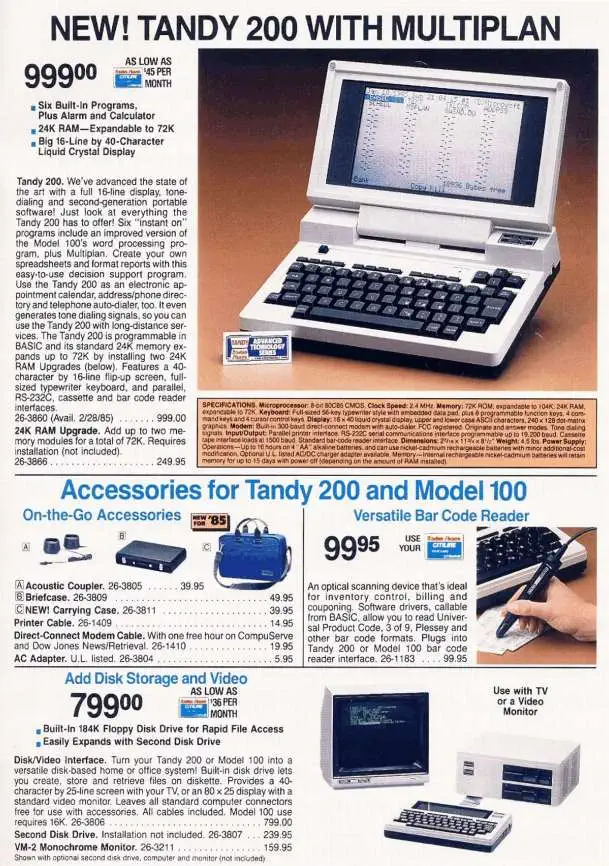The Tandy M200 Portable
The Tandy M200 came with built-in business software in ROM: a word processor, Multiplan, address book, calendar, among others. It had a built-in 300-baud direct-connect modem with auto-dialer, that could originate and answer calls from the address book. The computer was similar in architecture to the NEC-8201 line of computers and a direct descendant of the Tandy M100
Input/Output ports located on the back:
- Parallel printer interface
- RS-232C Serial port, up to 19,200 baud
- Cassette tape interface, up to 1500 baud
- Standard bar-code reader interface
- ROM expansion port
- Monitor port

HD44100 LCD Column Driver Chip
Key features and details of the HD44100 series (which includes HD44100, HD44102, and others):
LCD Column Driver The HD44100 series chips are designed to drive the columns of a dot matrix LCD display. In dot matrix LCDs, individual pixels are addressed using row and column coordinates.
Dot Matrix Displays These chips were used in small dot matrix displays, often found in pocket calculators, digital watches, and other portable electronic devices.
Controller and Driver The HD44100 series chips integrate both the controller and the driver circuitry required to interface with the LCD display.
Low Power As these chips were intended for use in battery-operated devices, they were designed to be low-power to conserve energy and extend battery life.
Limited Resolution The resolution supported by these chips was relatively low compared to modern displays. Typical displays using HD44100 series drivers might have resolutions on the order of 32x64 or similar.
Parallel Interface The chips used a parallel bus interface to communicate with the main microcontroller or system.
Intel 8085 CPU
The Intel 8085 microprocessor is produced by Intel in 1976. It is software-binary compatible with the Intel 8080, with two instructions added to support the newly added interrupt and serial I/O features.
The CPU requires less support circuitry, allowing foa a simpler and less expensive production process. The "5" in the 8085 signifies the single +5 volt power supply that is needed to power the CPU. In comparison the 8080 needed +5V, -5V and +12V in order to run.
The 8085 uses a multiplexed address/data bus (AD0 through AD7). Intel introduced several support chips with this address latch built in, such as the 8155 RAM chip, and I/O chips. This architecture reduced the number of traces between the 8085 and supporting memory and I/O chips.
The Zilog Z80 eclipsed both the 8080 and the 8085 in capabilities and added instructions. But thanks to the built-in serial I/O and five prioritized interrupts, the Intel 8085 played a large role as a controller in many products.

RAM max: 72kB
ROM: 72kB Sound Chip none Sound mono piezo beeper Display Chip Hitachi HD44102 Dot Matrix LCD Column Driver Chip Display 40x16 text mono Best Text 40x8 Best Color none Best Graphics 250x128 dot LCD Sprites n/a System OS TRS-DOS Storage External Tape drive, external disk drives Original Price $999

